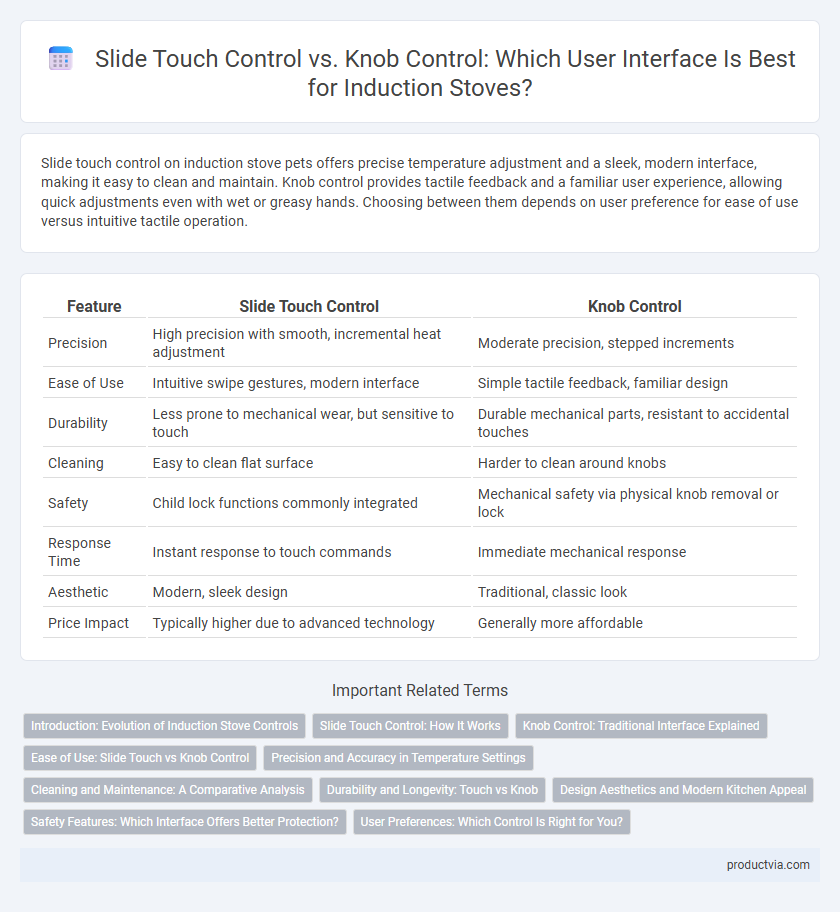Slide touch control on induction stove pets offers precise temperature adjustment and a sleek, modern interface, making it easy to clean and maintain. Knob control provides tactile feedback and a familiar user experience, allowing quick adjustments even with wet or greasy hands. Choosing between them depends on user preference for ease of use versus intuitive tactile operation.
Table of Comparison
| Feature | Slide Touch Control | Knob Control |
|---|---|---|
| Precision | High precision with smooth, incremental heat adjustment | Moderate precision, stepped increments |
| Ease of Use | Intuitive swipe gestures, modern interface | Simple tactile feedback, familiar design |
| Durability | Less prone to mechanical wear, but sensitive to touch | Durable mechanical parts, resistant to accidental touches |
| Cleaning | Easy to clean flat surface | Harder to clean around knobs |
| Safety | Child lock functions commonly integrated | Mechanical safety via physical knob removal or lock |
| Response Time | Instant response to touch commands | Immediate mechanical response |
| Aesthetic | Modern, sleek design | Traditional, classic look |
| Price Impact | Typically higher due to advanced technology | Generally more affordable |
Introduction: Evolution of Induction Stove Controls
Slide touch control offers a modern and intuitive interface for induction stoves, enhancing precision and ease of use compared to traditional knob control systems. While knob controls provide tactile feedback and familiarity, slide touch panels enable smoother power adjustments and integration with smart features. This evolution in induction stove controls reflects advancements in technology aimed at improving user experience and efficiency.
Slide Touch Control: How It Works
Slide touch control on induction stoves operates through capacitive sensors that detect finger movement along a designated control strip, allowing precise temperature adjustments. This interface offers a seamless, flat surface that enhances easy cleaning and provides quick response times compared to traditional knob controls. By registering continuous sliding input, users can fine-tune heat levels smoothly without increments imposed by physical detents found in knob systems.
Knob Control: Traditional Interface Explained
Knob control in induction stoves offers a tactile, precise way to adjust temperature settings, providing users with immediate feedback through physical rotation. This traditional interface enables effortless changes without the need for visual confirmation, enhancing usability for experienced cooks. Knobs also maintain durability and simplicity, reducing the risk of malfunction compared to more complex digital slide touch controls.
Ease of Use: Slide Touch vs Knob Control
Slide touch control on induction stoves offers precise temperature adjustments with a simple swipe, enhancing ease of use for smooth and quick operation. Knob control provides tactile feedback and familiar rotary movement, preferred by users who favor physical interaction for immediate control. Slide touch controls streamline cleaning and reduce wear, while knob controls offer intuitive handling, allowing users to choose based on comfort and preference.
Precision and Accuracy in Temperature Settings
Slide touch control on induction stoves offers enhanced precision and accuracy in temperature settings by allowing continuous and smooth adjustments, enabling users to fine-tune heat levels with minimal increments. Knob control provides tactile feedback but often lacks the granularity of slide touch systems, resulting in less precise temperature management. Advanced slide touch interfaces typically integrate digital sensors for real-time temperature regulation, optimizing cooking performance and energy efficiency.
Cleaning and Maintenance: A Comparative Analysis
Slide touch control induction stoves offer a smooth, flat surface that makes cleaning effortless by eliminating crevices where dirt and grease accumulate. Knob control models have physical buttons and gaps that trap food particles, requiring more detailed maintenance and frequent disassembly for thorough cleaning. The seamless design of slide touch controls enhances hygiene and reduces long-term upkeep compared to traditional knob interfaces.
Durability and Longevity: Touch vs Knob
Slide touch control interfaces on induction stoves offer enhanced durability due to the absence of mechanical parts that can wear out over time, unlike traditional knob controls which are prone to physical damage and degradation from frequent turning. The sealed glass surface of slide touch controls resists spills and dirt infiltration, improving longevity and reducing maintenance needs. In contrast, knob controls are susceptible to loosening and breaking, often requiring replacement more frequently than their touch-based counterparts.
Design Aesthetics and Modern Kitchen Appeal
Slide touch control offers a sleek, minimalist design that enhances the modern kitchen's aesthetic appeal by providing a seamless, flat surface free of protruding elements. Knob control, while traditional, adds a tactile and retro charm but can disrupt the clean lines favored in contemporary kitchen designs. The smooth interface of slide touch controls aligns with the trend toward integrated, futuristic appliances that elevate overall kitchen elegance.
Safety Features: Which Interface Offers Better Protection?
Slide touch controls on induction stoves offer enhanced safety features such as child lock functions and automatic shut-off mechanisms that reduce accidental burns and misuse. Knob controls, while familiar, lack precise locking options, increasing the risk of unintended activation or temperature changes. Overall, slide touch interfaces provide superior protection by integrating advanced safety settings directly into the user interface.
User Preferences: Which Control Is Right for You?
Slide touch control on induction stoves offers sleek, precise adjustments ideal for tech-savvy users who prefer modern aesthetics and easy cleaning. Knob control provides tactile feedback and intuitive operation, favored by those who value traditional interfaces and rapid temperature changes. Your choice depends on whether you prioritize minimalist design and fine-tuned control or hands-on familiarity and tactile responsiveness.
Slide touch control vs Knob control for user interface Infographic

 productvia.com
productvia.com